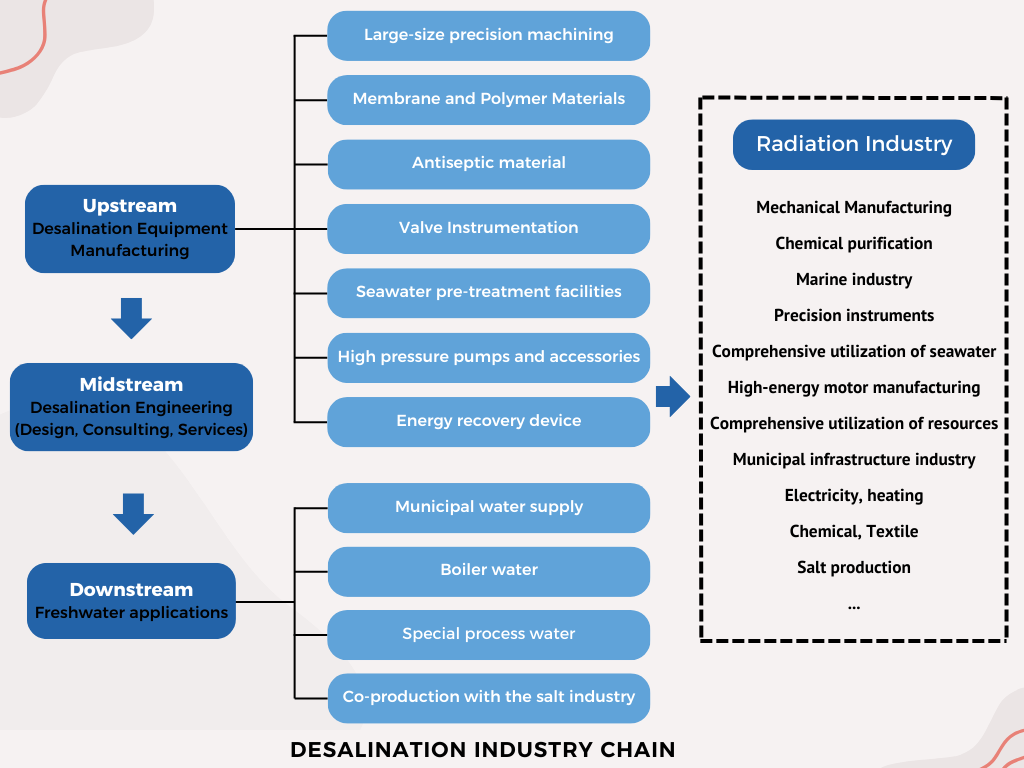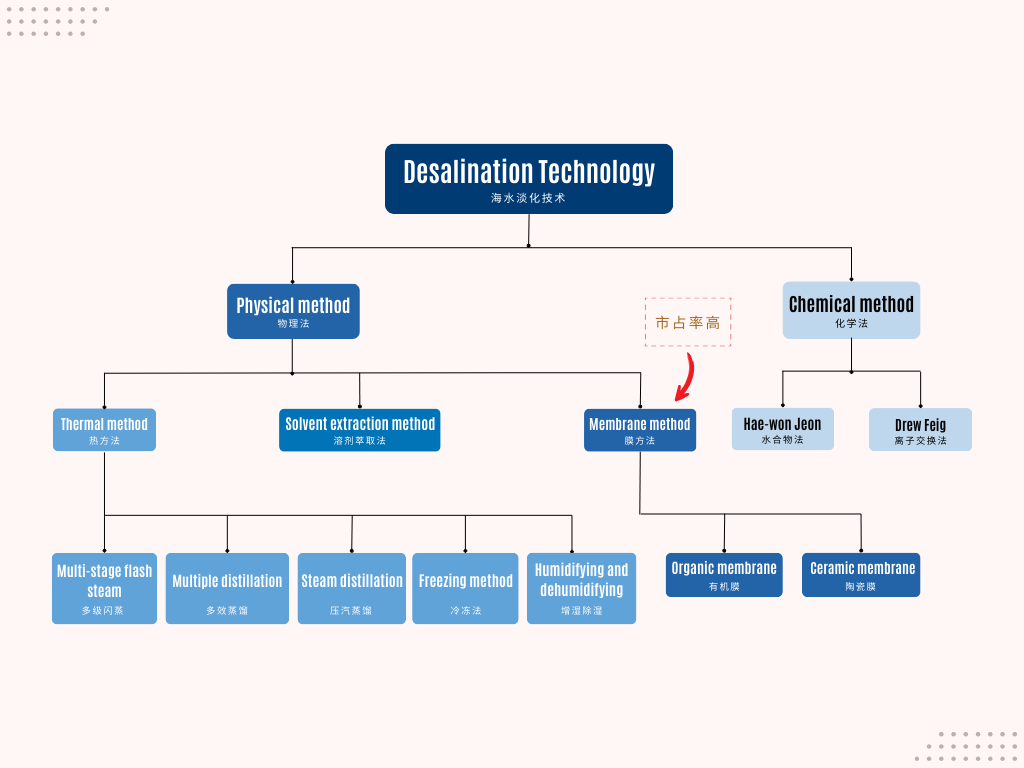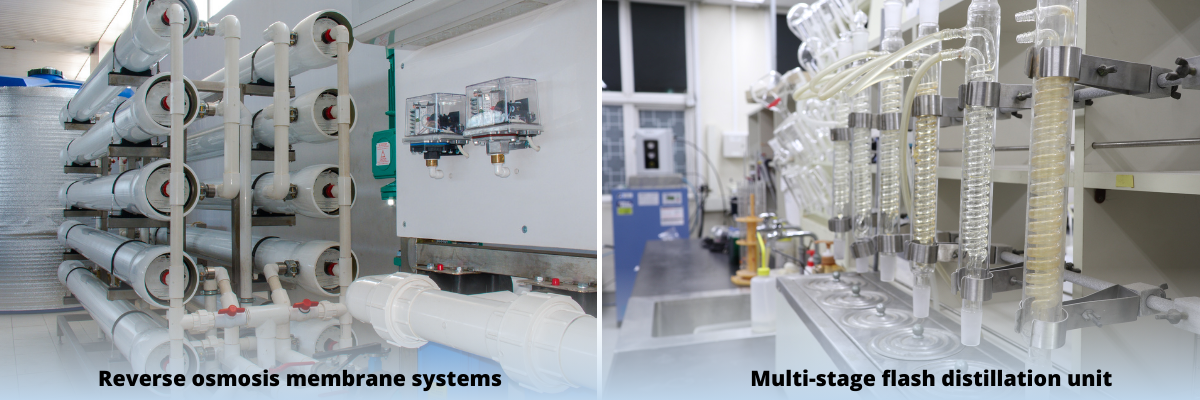Overview
Global water scarcity has become a major challenge. Despite the dramatic rise in demand for freshwater due to population growth and urbanization, only 2.5 per cent of freshwater resources are available. Desalination technology converts seawater into usable fresh water by removing salts and impurities from the water. This article will provide an industry overview of desalination overview, challenges, industry chain, technology and equipment.
Industry Chain
High-quality hardware, including reverse osmosis membrane systems and multi-stage flash distillation units, as well as components such as precision machining, corrosion-resistant materials and energy recovery units, are provided by upstream equipment suppliers. Midstream engineering companies are responsible for project design, consulting and implementation, including civil works, equipment installation and commissioning. Downstream application areas validate the practical benefits of desalination technology through municipal water supply, industrial water use and agricultural irrigation.

Desalination Technology
Seawater desalination technology is mainly divided into physical and chemical methods, with physical methods including thermal, extraction and membrane methods, and chemical methods including hydrate and ion exchange methods.
Multi-stage flash evaporation (MSF) and reverse osmosis (RO) are the most important desalination processes at present.

Desalination Equipment
Seawater desalination equipment is the core of realizing seawater desalination technology, and two of the most widely used equipment are reverse osmosis membrane system and multi-stage flash distillation device.
The reverse osmosis membrane system works by pressurizing seawater and passing it through a special semi-permeable membrane that allows water molecules to pass through while salts and impurities are filtered. This equipment is suitable for smaller scale facilities and requires multiple system integration for large treatment volumes. It is characterized by low energy consumption and compact equipment, but the membranes are costly and need to be replaced periodically.
The multi-stage flash distillation unit vaporizes seawater by heating it and then removes salts and impurities through multi-stage filtration. This unit has high treatment efficiency and consistent quality of finished water, but has high energy consumption and is suitable for high temperature regions such as the Middle East and North Africa for municipal and industrial water supply.
Electrodialysis device using electric field and selective ion exchange membrane separation of ions in seawater, suitable for treatment of low salinity water, energy consumption is relatively low, mainly used for industrial wastewater treatment and water reuse.
Water intake pressurization facilities such as pumping stations and pressure vessels provide the necessary pressure support for the desalination process. Such facilities are diverse and can be adapted to different process requirements, and are used in a variety of desalination processes.
Water purification facilities include filters and sterilizers to further purify the treated fresh water to meet drinking water standards and improve water quality. These facilities are used in the final treatment of municipal and industrial water supplies.

Industry Capacity Analysis
According to the statistics, there are about 14,000 desalination plants in the world, with a daily production of about 36.2 million tons. As of October 2022, the world can produce 107.95 million cubic meters of fresh water per day, and the number of desalination plants reaches 22,757. These figures show that the production of desalination projects is increasing year by year, reflecting the rising demand for desalination technology in various countries, and the production is expected to continue to grow in the future.
The application market of seawater desalination engineering mainly focuses on the drinking water sector, accounting for about 80%. The Middle East and the United States are the main markets, with Saudi Arabia accounting for 22% of the global total, the United States for 15%, Europe for 12% and the United Arab Emirates for 11%. The Middle East has a high demand for desalination technology due to the lack of water resources in the region as a result of natural constraints. The Jebel Ali desalination plant in the UAE is the largest in the world, generating 300 million cubic meters of fresh water per year.
In recent years, new desalination projects have been increasing in various countries, and the number of projects is expected to continue to grow in the coming years.The global desalination industry size was estimated at USD 18.26 billion in 2019, and is expected to rise to USD 26.3 billion by 2025.The market size was estimated at USD 19.29 billion in 2021, and is projected to grow at a compounded growth rate (CAGR) of 8.8% over the period 2022-2028 ( CAGR) growth and the market size will reach USD 34.6 billion by 2028. Rising urbanization rate and population growth across the globe are the key factors driving the market growth, while climate change, increasing pollution, and water scarcity are also boosting the investment and construction of desalination facilities.
The desalination equipment market is categorized by technology, application, and region. Reverse osmosis membrane technology dominates the global desalination market, accounting for over 70% of the market share; municipal water supply is the major application area, accounting for 60% of the market share; and the Middle East and North Africa is the largest regional market, accounting for 30% of the market share.
The global desalination equipment market size was approximately $160.8 billion in 2022, with a compound annual growth rate (CAGR) of approximately 15.6% from 2018-2022. It is expected to continue to grow in the future and the market size will be close to $448.7 billion by 2029.
CHART: Global large-scale desalination project engineering application cases
Conclusion
The global desalination market has a broad prospect. With technological advances and growing demand, desalination will become an important water resource solution in the future, and MTSCO will play an important role in the development of the industry with its high-performance products, contributing to the sustainable development of society and economy.
Cited sources
1. Emirates National Desalination Company. (2023). Jebel Ali Desalination Plant Overview.
2. Environmental Protection Agency. (2022). Impact of Desalination on Marine Environment. Washington, DC: EPA.
3. Global Desalination Market Report. (2023). Comprehensive Analysis of the Desalination Industry. London: Water Market Research.
4. Global Market Research Company. (2022). Desalination Industry Trends and Projections.
5. Global Water Intelligence. (2022). Desalination Plants and Projects Database. Oxford: GWI.
6. Global Water Resources Management Report. (2022). Industrial and Agricultural Use of Desalinated Water.
7. Global Water Treatment Equipment Market Report. (2023). Analysis of Desalination Equipment Suppliers.
8. Industrial Water Treatment Journal. (2023). Application of Desalinated Water in Industry.
9. International Desalination Association. (2022). State of the Industry Report. London: IDA.
10. International Desalination Association. (2022). Market Overview and Forecast. London: IDA.
11. International Resource Management Institute. (2023). Future Trends in Desalination.
12. International Water Management Institute. (2022). Advances in Desalination Technology. Colombo: IWMI.
13. Municipal Water Annual Review. (2023). Urban Water Supply through Desalination. New York: Municipal Water Association.
14. Saudi Desalination Research Center. (2022). Annual Report on Water Production. Riyadh: SDRC.
15. United Nations. (2021). World Water Development Report 2021. New York: United Nations.
16. Wikipedia. (2022). Seawater Desalination. Retrieved from https://en.wikipedia.org/wiki/Seawater_desalination.
17. World Bank. (2023). Financing Desalination Projects in Developing Countries. Washington, DC: World Bank.
18. World Desalination Association. (2023). Global Desalination Market Analysis. London: WDA.
19. Agricultural Science Journal. (2023). Use of Desalinated Water in Irrigation.
20. Desalination Technology Research Institute. (2023). Seawater Desalination Challenges.
21. Engineering Technology Magazine. (2023). Desalination Project Planning and Implementation.
22. International Engineering Consulting Company Report. (2023). Technical Consulting for Desalination Projects.

